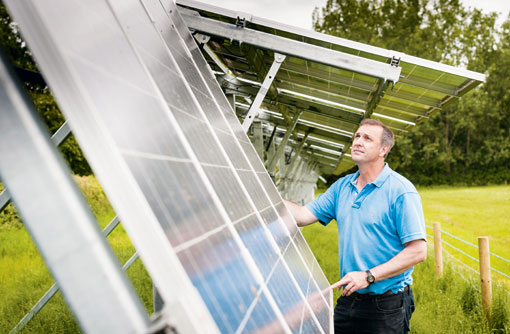Green Energy Farmer Award shortlist: Steve Edmunds

Pioneering new technologies and showing how varied a farmer’s skill set can be, this year’s Green Energy Farmer of the Year finalists demonstrate the many benefits of “energy farming”. Will Frazer uncovers three powerful voices committed to proving the many ways farmers can drive a greener and more prosperous society
Steve Edmunds
Ashcott Farm, Bridgewater, Somerset
Steve Edmunds is a pioneer and he’s on a mission to show how renewable energy can keep farmers farming.
Managing a 200-head dairy herd in partnership with his brother and a director of the Mole Valley Farmers co-op, Steve had a moment of enlightenment six years ago when he went to the board of MVF and said “I perceive renewable energy will become hugely important for the rural economy”.
He has lived by his convictions and installed 90kW of ground-mounted solar PV on the farm, which displaces 50% of imported power from the 200-cow dairy unit, three farm dwellings and a neighbouring poultry unit.
Through the Feed-in Tariff, the arrays earn the farm £41,500 a year and have a simple return on investment of 16%. This complements the turnover of the dairy farm and enables the farm to support two families. In addition, two 25kW biomass boilers displace use of heating oil for the two houses and save 60 tonnes of carbon a year.
Steve describes himself as “the first of a new breed of energy farmers” that due to government incentives have a unique chance for a guaranteed income for 25 years and run two livelihoods off the same land.
“It’s like an orchard – you still get the grazing, but you just get another crop at another level,” he says.
Steve is passionate about translating technology from first principles to practical application on farm. This is where he started 25 years ago, when he led the development of market-leading homofermentative inoculants that not only improved the quality of millions of tonnes of silage each year but also have an important role in carbon reduction.
“One of my guiding principles here is that we design technologies that do not conflict with food production.”
Steve Edmunds
His practical approach to farm engineering is now devoted to renewable energy on farms and he was the first person to receive planning for ground-mounted solar PV in the country – a system he built himself. Counter to conventional wisdom, Steve believed that solar cells would operate more efficiently in cooler conditions on the ground. His arrays now produce 21% more power than their predicted output.
The 90kW of solar PV on the farm is as much a money maker as it is a test-bed for panel efficiency and crucially a demonstration site. More than 2,500 people have visited the site in the past two years – mostly farmers, but also planners, bankers and insurers. Through those that he knows have installed solar PV off the back of his demonstration, he estimates nearly £1.6m is now coming back into the rural economy through the Feed-in Tariff alone.
His most recent addition to the farm was a 5kW wind turbine to further supplement the power needs of the dairy but also to prove that wind is a viable energy source. “Around here, wind turbines are like a religion,” he says. “But our power has got to come from somewhere.” A 15kW ground-source heat pump and solar thermal system also provide heat for the workers cottages.
For Steve, renewable energy is a useful safety net, with his dairy farm squeezed by the consequences of bovine TB and low market prices.
But that doesn’t mean he’s complacent about farming. “One of my guiding principles here is that we design technologies that do not conflict with food production,” he says.
Steve can be best summed up by the recycled solar panel that he has placed on top of his inverter housing to power an old electric car fan to cool the inverters and keep them operating efficiently – innovative, practical and effective.
Next on his horizon is a low-cost anaerobic digestion system, being developed in partnership with Warwick University, which will help further reduce the farm’s carbon footprint. The hope though, as with all of Steve’s work, is that it will have widespread applicability and benefit many farmers.
“The hardest part of doing it first is learning the rules and regulations and getting it right for all the people following you,” he says.
 Marks & Spencer has been impressed with the quality and quantity of entries into this year’s Farmers Weekly Green Energy Award. This is another reminder that renewable energy production and agriculture are perfect partners with a robust economic case.”
Marks & Spencer has been impressed with the quality and quantity of entries into this year’s Farmers Weekly Green Energy Award. This is another reminder that renewable energy production and agriculture are perfect partners with a robust economic case.”
Hugh Mowat, Marks & Spencer, agronomist
See more
Meet the other 2012 finalistsFind out more about the 2012 Farmers Weekly Awards including details on how to books tables for the event’s glittering London awards bash
